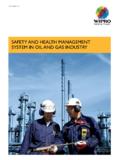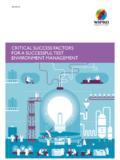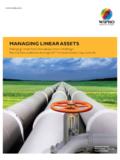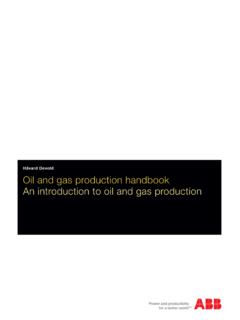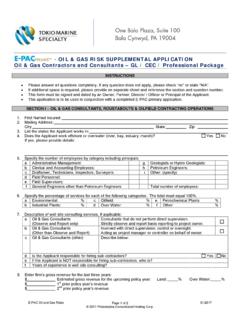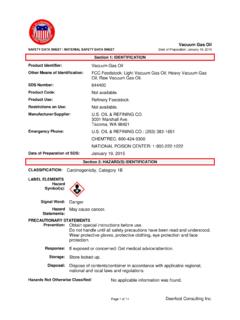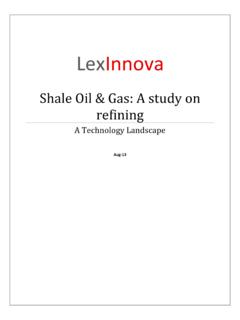Transcription of Downstream Oil and Gas: Achieving Excellence by ...
1 WHITE PAPER. Downstream oil and gas : Achieving Excellence by integrating operations Sponsored by: Wipro Jill Feblowitz July 2015. IN THIS WHITE PAPER. In this IDC White Paper, IDC Energy Insights discusses the best practice approaches of improving operations in today's Downstream oil and gas industry, particularly refining, gas processing, and petrochemicals. The focus is on organizing people, processes, and technology to achieve continuous improvements, taking advantage of recent advances in technology and new management techniques. Guidance is provided on what steps oil and gas companies can take to ensure that they meet their business objectives for profitability, growth, and product quality while mitigating risks to the environment, safety, and health. SITUATION OVERVIEW. With the low prices of crude and natural gas, refining, petrochemical, and processing margins are experiencing a comeback after years of lackluster performance.
2 These conditions are not likely to persist. Operating costs will increase with more stringent regulation of emissions and safety. Availability and uptime may be affected by operating equipment at higher utilization rates, especially for equipment that has been performing under capacity. In the long run, prices of feedstock are likely to increase with the lifting of export bans and the development of liquefied natural gas (LNG) infrastructure. At the same time, competition will place pressure on wholesale refined product prices. Sitting in the middle of the energy value chain between producers and consumers Downstream leadership needs to be prepared to respond quickly to changing conditions. With a wealth of information more easily available, now is the perfect time for lines of business and information technology (IT) organizations to develop the means to orchestrate the organizational response by integrating operations .
3 Supply Chain Is Changing Long-Term Demand Shifts to Asia and the Middle East Demand for energy, particularly oil and natural gas, is shifting to Asia and the Middle East. According to the New Policies Scenario in the International Energy Agency's (IEA's) 2014 World Energy Outlook, from 2013 to 2025, demand for oil will decrease in OECD countries while increasing by 42% for China, 57% for India, and 26% for the Middle East (see Figure 1). (Note: Countries in the OECD . Organisation for Economic Co-operation and Development are Australia, Austria, Belgium, Canada, Chile, the Czech Republic, Denmark, Estonia, Finland, France, Germany, Greece, Hungary, Iceland, Ireland, Israel, Italy, Japan, Korea, Luxembourg, Mexico, the Netherlands, New Zealand, Norway, July 2015, IDC Energy Insights #EI257108. Poland, Portugal, Slovakia, Slovenia, Spain, Sweden, Switzerland, Turkey, the United Kingdom, and the United States.)
4 FIGURE 1. Change in Demand for Oil, 2013 2025, New Policies Scenario 60. 50. (Million barrels per day). 40. 30. 20. 10. 0. 2013 2020 2025. OECD. Non-OECD. China India Middle East Source: International Energy Agency's World Energy Outlook, 2014. Globally, the demand for oil over the coming years will focus on transport and refined products rather than generation, according to the IEA. As for transport, the United States and Europe are just coming out of a period of lowered gasoline consumption motivated by the economy, fuel efficiency standards, and high prices, although lower crude oil prices are driving more consumption with the return to larger vehicles. On the other hand, demand for transport fuel is increasing in Asia and the Middle East, in part due to subsidies that give advantage to fossil fuels for transport and despite adoption of the first fuel efficiency standards in China and India.
5 As for petrochemicals, production is expected to grow from million barrels per day (MBPD) in 2013 to MBPD in 2025. According to the IEA in the 2014 World Energy Outlook, "Together with China and the Middle East, the United States sees the highest increase in oil consumption for petrochemicals to 2025.". In its New Policies Scenario, the IEA forecasts that the "demand for natural gas grows by more than half, the fastest rate among the fossil fuels, and increasingly flexible global trade in liquefied natural gas [LNG] offers some protection against the risk of supply disruptions." China saw 18% growth in demand for natural gas from 2012 to 2013, according to the IEA. The demand for natural gas in China is expected to increase as the country seeks to substitute coal-fired generation with cleaner burning gas. The Middle East is also expected to see an increase in the demand for natural gas.
6 2015 IDC Energy Insights #EI257108 2. The Rise of Unconventionals The rise of unconventionals tight oil, shale gas, oil sands, and deep water over the past several years has radically changed the oil and gas industry. The International Energy Agency's announcement in November 2012 that the United States would be able to meet all of its energy needs internally and become a net exporter of oil and gas in the 2030s raised eyebrows. Figure 2 shows that from 2013 to 2025, the rate of growth of crude will decline, while the rate of growth of natural gas liquids (NGLs), extra heavy oil found in the oil sands, and tight oil will increase. FIGURE 2. Changes in World Oil Production by Type, 2013 2025 and 2025-2040. Crude oil NGLs Extra heavy oil Tight oil Other -4 -2 0 2 4 6 8 10. (%). 2013-2025. 2025-2040. Source: International Energy Agency's World Energy Outlook, 2014.
7 2015 IDC Energy Insights #EI257108 3. Refining Moves Close to Demand Much of the new refining capacity is located in proximity to demand as a result of the expense of delivering refined products. Exports of crude to Asia for processing are at record highs. Figure 3 displays the clear growth in capacity in Asia and the Middle East, followed by North America, while Europe has shuttered capacity. Proximity to demand depends on whether it is premium product or commodity that is a by-product, the cost of feedstock, and the transportation of feedstock that may not be local. FIGURE 3. Refining Capacity Changes, 2009-2014. North America Latin America Europe Africa Middle East Russia Asia/Pacific Japan and Australia -2,000-1,500-1,000 -500 0 500 1,000 1,500 2,000. (Million barrels per day). Source: Turner, Mason & Company, 2015.
8 At the same time, there is excess refining capacity in the world. According to the 2015 edition of BP's Energy Outlook, "Global spare refining capacity is already 7 Mb/d above its recent low [2005]. and, in recent years, a net 1 Mb/d additional capacity has been added each year." The conclusion is that there will be a long period of volatile margins with capacity reductions in areas like Europe. 2015 IDC Energy Insights #EI257108 4. LNG Rises to Meet Global Demands Natural gas is becoming a more global commodity. With access to natural gas constrained in Europe and demand rising for cleaner fossil fuel, the interest in LNG has grown. Royal Dutch Shell has made a large investment in LNG with its acquisition of the BG Group so that it can gain scale in the market. Building the infrastructure to support LNG processing natural gas pipelines, liquefaction, and regasification plants requires significant investment, so LNG operations put a premium on efficiency to achieve return on investment.
9 Price Volatility Picks Up A significant drop in oil prices in the fall of 2014 was largely due to unanticipated production in Libya, along with shale and tight oil production in North America. This drop benefited refinery margins for a period of time while product prices were still high. How quickly prices will recover is the topic of much speculation. What is clear, however, is that there is increased price volatility in feedstock (see Figure 4). FIGURE 4. Percent of Price Volatility in Crude Oil and Natural Gas, January 2014 to May 2015. 30. 20. 10. (%). 0. -10. -20. -30. Mar-14. Mar-15. Oct-14. Jun-14. Feb-14. Aug-14. Nov-14. Dec-14. Feb-15. Apr-14. Jul-14. May-14. Sep-14. Apr-15. May-15. Jan-14. Jan-15. Europe Brent Spot Price FOB (dollars per barrel). WTI Spot Price FOB (dollars per barrel). Henry Hub Natural Gas Spot Price (dollars per million Btu).
10 Source: Department of Energy, Energy Information Administration, June 2015. Refiners Benefit from Drop in Oil Prices Margins have seen a boost as crack spread grows with the low price of oil. In fact, for vertically integrated companies in today's environment, refining is adding value to vertically integrated companies. According to one refining and retail company, in addition to stable cash flow and environmental performance, "Refinery margins is [sic] probably the area where we as a company, and probably most oil companies, have the most potential to add value to their bottom line by improving refinery margins and we're no exception to that.". 2015 IDC Energy Insights #EI257108 5. According to the IEA, "Refinery margins have been on an upward trend since mid-2014, despite initially lackluster demand growth. More recently, cold weather and lower retail product prices helped spur stronger demand growth in some countries.
